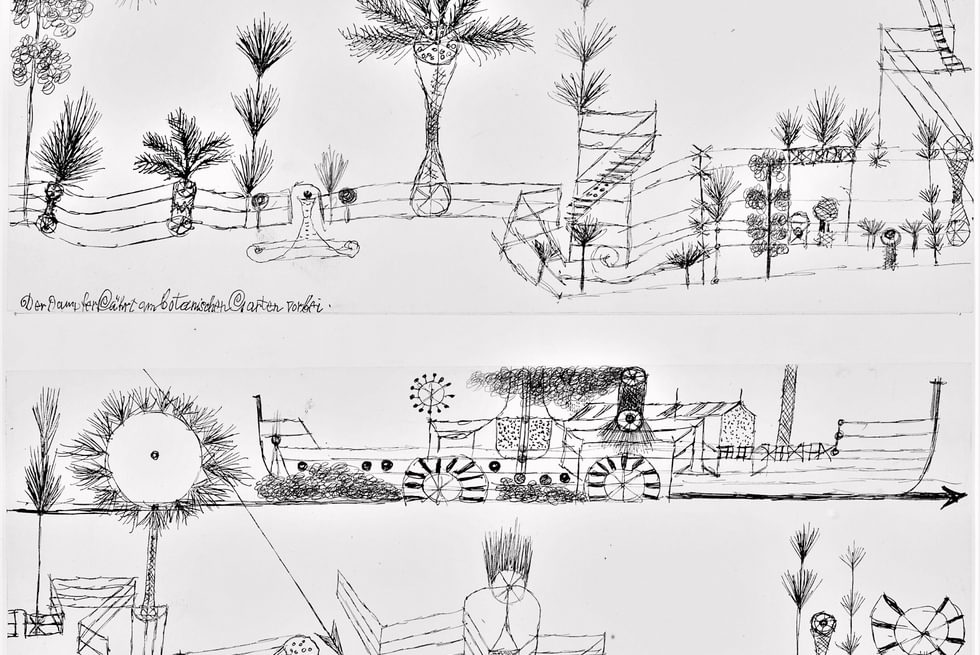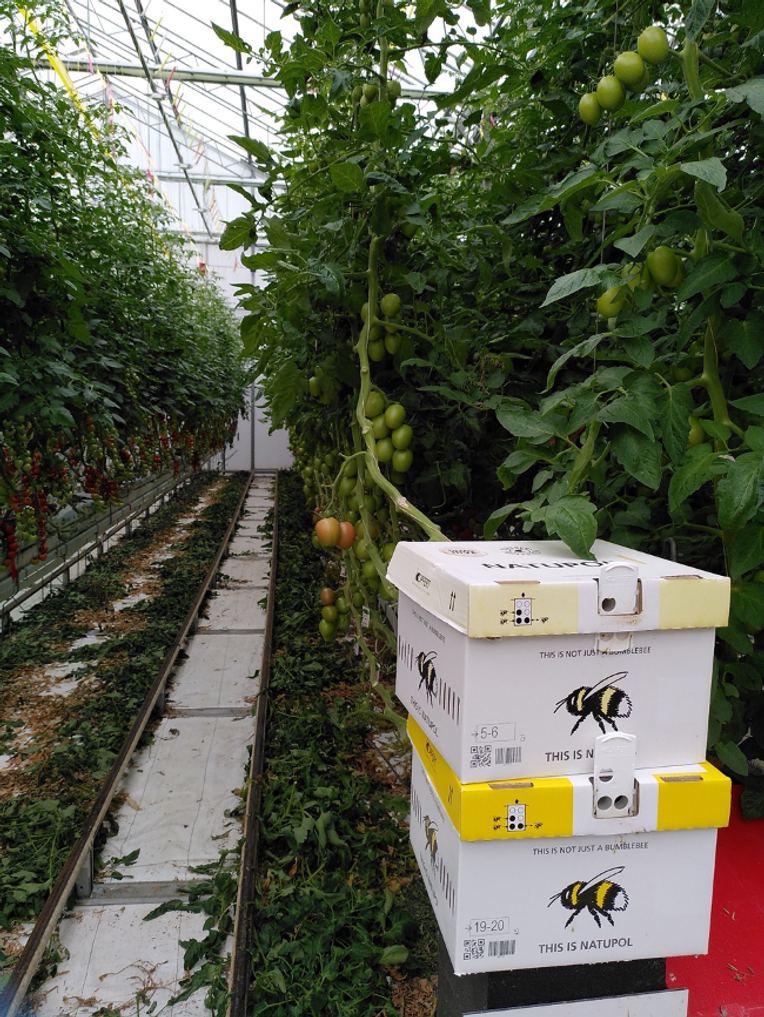The New Plantation
From the Series: Plantationocene
From the Series: Plantationocene

Snoep tomaten or “candy tomatoes” are ubiquitous in Dutch supermarkets. Offered in plastic boxes of different sizes, they are now one of the country’s most popular vegetables. Yet, tomatoes are relatively new in the country. Their ubiquity in the Netherlands has been enabled by what I consider in this essay an engine of planetary transformation: the greenhouse and its entourage of biota that circulates all over the world. Here, I track the relation between pollinator bumblebees and Dutch tomatoes amidst the wider backdrop of the planetary transformations brought about within industrial food production.
In the years following the end of the Second World War, and as a direct result of war tactics, Dutch farmers became horticultural world leaders, particularly in tomatoes and flowers. During the war, the Allies inundated enormous hectares of land with sea water to prevent the advance of the Germans. In a country with an extraordinary pressure on land, together with the great famine that followed the war, the loss of land prompted important changes. The Dutch government devised a national program to sponsor a rapid transition towards greenhouse horticulture, giving farmers interest-free loans and direct income support to start using greenhouses (Berkers and Geels 2011). In the cold landscape of the Netherlands, these greenhouses were heated with natural gas. Planners and government officials assumed that nuclear power would be the certain solution to future energy problems, and the state wanted to get rid of gas quickly.
While Dutch farmers became tomato growers, new problems became evident. Spanish greenhouse horticulture in Almeria became a huge competitor in tomato exports. At the same time, the taste of the Dutch tomato was not pleasing to some eaters, who emphasized their blandness. The Dutch tomato exporting crisis peaked in the 1980’s when tomatoes were called wasserbomben (water bombs) on German television, ridiculed for their watery and tasteless qualities, despite their shiny appearance (Heuts and Mol 2013). Germany, the main export destination for Dutch tomatoes, discarded them provoking a disastrous halt to Dutch exports, meaning that production soon collapsed.
This crisis marked a frenetic time in greenhouse innovation, from marketing to seed research. Westland tomato grower Ton Janssen and his efforts to grow new tomato varieties that could position the Netherlands in the export market again culminated with the launch of a new tomato variety, branded with a juicy marketing name in 1995: the “Tasty Tom” (Stallen et al. 2004). From this point on, and in different intensities, greenhouse growers in the area cultivated new varieties of tomatoes for the international and national market. As a result, an assortment of tomatoes came into being, each catering to a different taste: sweeter, smaller, variously colored, or juicier.
A few decades earlier and in the same region as Ton Janssen’s tomatoes, a Westland cucumber grower found himself increasingly troubled with infestations of red spider mites damaging the leaves of his plants (Koppert Biological Systems 2017). The chemicals he normally used to kill the mites were losing effect and the arthropods soon became resistant. On top of that, Jan Koppert himself became sensitive to these chemicals. Looking for a solution to both his own reaction to the chemicals and the resistant mites, he became interested in finding alternatives to chemical control in the indoor spaces of the Westland greenhouse, leading to the creation of the first biological control business in the region. The business continued with his sons Peter and Paul, who made a breakthrough in 1988 when they succeeded to breed their own colonies of bumblebees (how they managed is a trade secret) to be used as pollinators in indoor greenhouses (Church 2021).
To a large extent the bumblebee colonies commercialized by the Koppert family are responsible of the enormous expansion of the greenhouse landscape in the Netherlands, and the success of the “Tasty Tom.” As much as 80 percent of Dutch tomato growers use bumblebees’ colonies to pollinate their crops. The work of humans as pollinators was made redundant with the introduction of these commercialized bumblebee colonies. More importantly for this collection, bumblebees replaced cheap human labor with even cheaper other-than-human work, rendering the work of bumblebees decisive for value extraction. Thanks to the other-than-human work of bumblebees, greenhouses grew in dimension and profitability, bumblebees pollinated impeccably, and the quantity and quality of the yields increased.

Examination of the greenhouse industrial food system in the Netherlands, as a “material formation” (Chao 2022) offers new grounds for analyzing European industrial food systems. Firstly, the cheap work of bumblebees in greenhouses crucially accounts for the massive growth in scale and profitability of industrial greenhouse food systems. The unpaid other-than-human work insects perform (Barua 2018), not only yields cheap commodities but becomes pivotal for the maintenance of the simplified ecologies in which tomatoes are grown. Greenhouses entail some vital facets of the Plantationocene: they train attention to ecologies of extraction and labor, and how these are created in specific societies, through specific historical and environmental processes. The modern greenhouse, with its simplified ecologies, reliance on other-than-human work, and infrastructures to produce cheap commodities, one might argue, is the new plantation.
Barua, Maan. 2018. “Animal Work: Metabolic, Ecological, Affective.” Theorizing the Contemporary: The Naturalization of Work. Fieldsights, July 26.
Berkers, Eric, and Frank Geels. 2011. “System Innovation through Stepwise Reconfiguration: The Case of Technological Transitions in Dutch Greenhouse Horticulture (1930–1980).” Technology Analysis & Strategic Management 23: 227–247.
Chao, Sophie. 2022. “Plantation.” Environmental Humanities 14, no. 2: 361–366.
Church, Dana L. 2021. The Beekeepers: How Humans Changed the World of Bumble Bees. Jefferson City, Mo.: Scholastic.
Heuts, Frank, and Annemarie Mol. 2013. “What Is a Good Tomato? A Case of Valuing in Practice.” Valuation Studies 1, no. 2: 125–46.
Koppert Biological Systems. 2017. Partners with Nature. Fifty Years of Koppert’s Biological Systems. Beeld: Sies van Hintum.
Stallen, M. P. K., et al. 2004. Kenniscirculatie en innovatie: de zoektocht van agrarisch Nederland. Denn Haag: LEI.